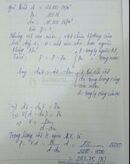Hãy nhập câu hỏi của bạn vào đây, nếu là tài khoản VIP, bạn sẽ được ưu tiên trả lời.

a) Để giá trị biểu thức 5 – 2x là số dương
<=> 5 – 2x > 0
<=> -2x > -5 ( Chuyển vế và đổi dấu hạng tử 5 )
\(\Leftrightarrow x< \frac{5}{2}\)( Chia cả 2 vế cho -2 < 0 ; BPT đổi chiều )
Vậy : \(x< \frac{5}{2}\)
b) Để giá trị của biểu thức x + 3 nhỏ hơn giá trị biểu thức 4x - 5 thì:
x + 3 < 4x – 5
<=< x – 4x < -3 – 5 ( chuyển vế và đổi dấu các hạng tử 4x và 3 )
<=> -3x < -8
\(\Leftrightarrow x>\frac{8}{3}\)( Chia cả hai vế cho -3 < 0, BPT đổi chiều).
Vậy : \(x>\frac{8}{3}\)
c) Để giá trị của biểu thức 2x +1 không nhỏ hơn giá trị của biểu thức x + 3 thì:
2x + 1 ≥ x + 3
<=> 2x – x ≥ 3 – 1 (chuyển vế và đổi dấu các hạng tử 1 và x).
<=> x ≥ 2.
Vậy x ≥ 2.
d) Để giá trị của biểu thức x2 + 1 không lớn hơn giá trị của biểu thức (x - 2)2 thì:
x2 + 1 ≤ (x – 2)2
<=> x2 + 1 ≤ x2 – 4x + 4
<=> x2 – x2 + 4x ≤ 4 – 1 ( chuyển vế và đổi dấu hạng tử 1; x2 và – 4x).
<=> 4x ≤ 3
\(\Leftrightarrow x\le\frac{3}{4}\)( Chia cả 2 vế cho 4 > 0 )
Vậy : \(x\le\frac{3}{4}\)

\(ĐKXĐ:\hept{\begin{cases}x\ne\pm2\\x\ne0\end{cases}}\)
a) \(P=\left(\frac{x^2}{x^3-4x}+\frac{6}{6-3x}+\frac{1}{x+2}\right):\left(x-2+\frac{10-x^2}{x+2}\right)\)
\(\Leftrightarrow P=\left(\frac{x^2}{x\left(x-2\right)\left(x+2\right)}-\frac{6}{3\left(x-2\right)}+\frac{1}{x+2}\right):\frac{x^2-4+10-x^2}{x-2}\)
\(\Leftrightarrow P=\frac{x^2-2x\left(x+2\right)+x\left(x-2\right)}{x\left(x-2\right)\left(x+2\right)}:\frac{6}{x-2}\)
\(\Leftrightarrow P=\frac{x^2-2x^2-4x+x^2-2x}{x\left(x-2\right)\left(x+2\right)}\cdot\frac{x-2}{6}\)
\(\Leftrightarrow P=\frac{-6x}{6x\left(x+2\right)}\)
\(\Leftrightarrow P=\frac{-1}{x+2}\)
b) Khi \(\left|x\right|=\frac{3}{4}\)
\(\Leftrightarrow\orbr{\begin{cases}x=\frac{3}{4}\\x=-\frac{3}{4}\end{cases}}\)
\(\Leftrightarrow\orbr{\begin{cases}P=-\frac{1}{\frac{3}{4}+2}=-\frac{4}{11}\\P=-\frac{1}{-\frac{3}{4}+2}=-\frac{4}{5}\end{cases}}\)
c) Để P = 7
\(\Leftrightarrow-\frac{1}{x+2}=7\)
\(\Leftrightarrow7\left(x+2\right)=-1\)
\(\Leftrightarrow7x+14=-1\)
\(\Leftrightarrow7x=-15\)
\(\Leftrightarrow x=-\frac{15}{7}\)
Vậy để \(P=7\Leftrightarrow x=-\frac{15}{7}\)
d) Để \(P\inℤ\)
\(\Leftrightarrow1⋮x+2\)
\(\Leftrightarrow x+2\inƯ\left(1\right)=\left\{\pm1\right\}\)
\(\Leftrightarrow x\in\left\{-3;-1\right\}\)
Vậy để \(P\inℤ\Leftrightarrow x\in\left\{-3;-1\right\}\)

1)
ĐKXĐ: x\(\ne\)3
ta có :
\(\frac{x^2-6x+9}{2x-6}=\frac{\left(x-3\right)^2}{2\left(x-3\right)}=\frac{x-3}{2}\)
để biểu thức A có giá trị = 1
thì :\(\frac{x-3}{2}\)=1
=>x-3 =2
=>x=5(thoả mãn điều kiện xác định)
vậy để biểu thức A có giá trị = 1 thì x=5
1)
\(A=\frac{x^2-6x+9}{2x-6}\)
A xác định
\(\Leftrightarrow2x-6\ne0\)
\(\Leftrightarrow2x\ne6\)
\(\Leftrightarrow x\ne3\)
Để A = 1
\(\Leftrightarrow x^2-6x+9=2x-6\)
\(\Leftrightarrow x^2-6x-2x=-6-9\)
\(\Leftrightarrow x^2-8x=-15\)
\(\Leftrightarrow x=3\) (loại vì không thỏa mãn ĐKXĐ)

a) ĐKXĐ: \(\hept{\begin{cases}2x-2\ne0\\x^2-1\ne0\\2x+2\ne0\end{cases}}\)\(\Leftrightarrow\hept{\begin{cases}x\ne1\\x\ne-1\end{cases}}\)
b) bạn rút gọn, biểu thức sẽ bằng 4
=> giá tri của biểu thức sẽ không phụ thuộc vào biến x
tôi vướng ở câu b giải cứ bị lẫn giải ra vẫn có biến x giải họ tôi cái

bài1 A=\(\left(\frac{3-x}{x+3}\cdot\frac{x^2+6x+9}{x^2-9}+\frac{x}{x+3}\right):\frac{3x^2}{x+3}\)
=\(\left(-\frac{x-3\cdot\left(x+3\right)^2}{\left(x+3\right)^2\cdot\left(x-3\right)}+\frac{x}{x+3}\right):\frac{3x^2}{x+3}\)
=\(-\frac{x}{x+3}\cdot\frac{x+3}{3x^2}=\frac{-1}{3x}\)
b) thế \(x=-\frac{1}{2}\)vào biểu thức A
\(-\frac{1}{3\cdot\left(-\frac{1}{2}\right)}=\frac{2}{3}\)
c) A=\(-\frac{1}{3x}< 0\)
VÌ (-1) <0 nên 3x>0
x >0



a) \(P=\dfrac{2x-4}{x^2-4x+4}-\dfrac{1}{x-2}=\dfrac{2\left(x-2\right)}{\left(x-2\right)^2}-\dfrac{1}{x-2}\)
\(=\dfrac{2x-4-\left(x-2\right)}{\left(x-2\right)^2}=\dfrac{x-2}{\left(x-2\right)^2}=\dfrac{1}{x-2}\)
ĐKXĐ: \(x\ne2\) nên với x = 2 thì P không được xác định
\(Q=\dfrac{3x+15}{x^2-9}+\dfrac{1}{x+3}-\dfrac{2}{x-3}\)
\(=\dfrac{3\left(x+5\right)}{\left(x-3\right)\left(x+3\right)}+\dfrac{1}{x+3}-\dfrac{2}{x-3}\)
\(=\dfrac{3x+15+x-3-2\left(x+3\right)}{x^2-9}=\dfrac{2x+6}{x^2-9}=\dfrac{2\left(x+3\right)}{\left(x+3\right)\left(x-3\right)}=\dfrac{2}{x-3}\)
Tại x = 2 thì \(Q=\dfrac{2}{2-3}=\dfrac{2}{-1}=-2\)
b) Để P < 0 tức \(\dfrac{1}{x-2}< 0\) mà tứ là 1 > 0
nên để P < 0 thì x - 2 < 0 \(\Leftrightarrow x< 2\)
Vậy x < 2 thì P < 0
c) Để Q nguyên tức \(\dfrac{2}{x-3}\) phải nguyên
mà \(\dfrac{2}{x-3}\) nguyên khi x - 3 \(\inƯ_{\left(2\right)}\)
hay x - 3 \(\in\left\{-2;-1;1;2\right\}\)
Lập bảng :
x - 3 -1 -2 1 2
x 2 1 4 5
Vậy x = \(\left\{1;2;4;5\right\}\) thì Q đạt giá trị nguyên
a) \(\dfrac{20x^3}{11y^2}.\dfrac{55y^5}{15x}=\dfrac{20.5.11.x.x^2.y^2.y^3}{11.3.5.x.y^2}=\dfrac{20x^2y^3}{3}\)
b) \(\dfrac{5x-2}{2xy}-\dfrac{7x-4}{2xy}=\dfrac{5x-2-7x+4}{2xy}=\dfrac{-2x+2}{2xy}=\dfrac{2\left(1-x\right)}{2xy}=\dfrac{1-x}{xy}\)